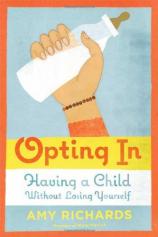Reading Group Guide
Discussion Questions
Opting In: Having a Child Without Losing Yourself

1. How did you react to the theme of the New York Times Magazine cover story that inspired this book and is described in the introduction? To what degree does media hype influence your mind-set about the evolving role of women—mothers or not—in American society? To what degree does the media’s portrayal of contemporary women match the realities of your own life?
2. In the introduction, Amy Richards outlines feminism’s accomplishments in the realm of motherhood and calls on readers to consider the power of the individual to effect change and to sustain the momentum of change. What impact have these accomplishments made on your own life? How has the role of mothers changed within your own family in recent generations, particularly in your mother’s and grandmother’s generations?
3. What revelations in Chapter 1: “To Work or Not to Work Is Not the Question,” were most surprising to you? Why does the all-or-nothing approach to careers and motherhood reign in most media coverage of the issue? Are the more essential facets—flexible schedules, paid family leave, parenting partners and equality in pay --- overlooked in the dialogues within your circle of friends, relatives, or coworkers?
4. Richards describes family-friendly European legislation that contrasts sharply with American lawmaking. In what way does this disparity reflect cultural values on both sides of the Atlantic? Is America’s corporate culture inherently at odds with the needs of its workers’ families?
5. What is the best way to cope with misinformation or hyperbole regarding biologically based parenting instincts and the challenges of contemporary parenting? To what extent did abortion debates of the 1970s shape the public’s perception of questions regarding women’s reproductive realities?
6. Richards provides a rich history of women who challenged conventional notions of motherhood before and during the rise of the Women’s Liberation Movement. Do you believe that, intentionally or not, the movement led to the marginalization of motherhood? Historically, how have race and economic status influenced the direction of such debates?
7. In reading Opting In, what did you discover about men and parenting, and men’s evolving perceptions of themselves as fathers? In what ways is fatherhood a feminist issue?
8. How do you personally define “real” birth? What is the best way to reconcile the roles of midwives, medical doctors, doulas, and mothers themselves in the process of giving birth and caring for a newborn? How should the tandem of privacy rights and public health be managed?
9. In Chapter 4: “William Doesn’t Want a Doll: Raising Kids Today,” Richards describes her own upbringing and the way it influenced her perception of herself and family definitions in general. How would you characterize her ultimate prescription for creating identities and definitions that liberate children from stereotypes of gender, race, and class?
10. What issues lie at the heart of gender-based parenting inequities? Are these issues primarily cultural, economic, psychological, biological, or something else altogether? Have you ever enacted a Marriage Agreement or a similar document? To what degree do you and the mothers in your circle welcome the concept of sharing parenting duties with fathers? Is fatherhood still essentially a symbol of virility and prosperity for most dads?
11. Richards offers wisdom for navigating the ways motherhood can affect a woman’s friendships. What is at stake for women who respond critically to their friends with children? What is the result of anxiety over whether parenting looks “too easy” or “too hard”? How significant do you think female friendships and a sense of sisterhood are in the lives of contemporary women?
12. How would you describe your relationship with your mother? Was she a barrier or a gateway to your individuality? Is a nurturing, maternal personality a prerequisite for a good mother (or a good father)?
13. Which of the organizations listed in the book’s Resource Guide are you likely to consult, either for information or to spur the types of actions described in the final paragraphs of Opting In? Do you feel satisfied with your level of involvement in furthering the cause? How would you answer the essential question posed in the closing chapter: “What do today’s parents want”?
14. Discuss the book’s title. What does a twenty-first-century woman opt for when she opts in to motherhood? What options does she have? Which options are difficult for her to access?
15. What predictions can you make regarding the ways our society’s daughters and granddaughters will address the issue of motherhood? Which debates are likely to wane, and which ones are likely to become even more heated in future generations? Will sweeping legislation be the key to change, or will reform be achieved through other means?
16. In what ways does Opting In expand on themes described in two books the author has coauthored, Manifesta: Young Women, Feminism, and the Future and Grassroots: A Field Guide for Feminist Activism? What makes Richards’s voice distinct from others participating in these dialogues?
Opting In: Having a Child Without Losing Yourself
- Publication Date: April 29, 2008
- Paperback: 316 pages
- Publisher: Farrar, Straus and Giroux
- ISBN-10: 0374226725
- ISBN-13: 9780374226725







